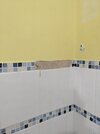Hiya
I'm planning on tiling my bathroom floor. It is currently lino over plywood (tongue and groove underneath) my plan is to:
Rip up the lino/plywood
Place down some 6mm backboards for the floor with adhesive
Add tape over the joints
Screw down
Tile over
Questions are:
Does this sound right?
What is a good backer board to use? I want good quality but I am on a budget so have been looking at the prowarm ones - can anyone recommend?
I also need to do the walls. Any tips on this would be great. Can you tile straight over the removed tiles depending on what's behind?
Thank you
I'm planning on tiling my bathroom floor. It is currently lino over plywood (tongue and groove underneath) my plan is to:
Rip up the lino/plywood
Place down some 6mm backboards for the floor with adhesive
Add tape over the joints
Screw down
Tile over
Questions are:
Does this sound right?
What is a good backer board to use? I want good quality but I am on a budget so have been looking at the prowarm ones - can anyone recommend?
I also need to do the walls. Any tips on this would be great. Can you tile straight over the removed tiles depending on what's behind?
Thank you


